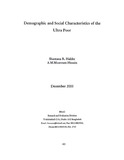| dc.contributor.author | Halder, Shantana R. | |
| dc.contributor.author | Husain, A.M.Muazzam | |
| dc.date.accessioned | 2019-08-29T05:38:45Z | |
| dc.date.available | 2019-08-29T05:38:45Z | |
| dc.date.issued | 2000-12 | |
| dc.identifier.citation | Halder, S. R., & Husain, A. M. M. (2000). Demographic and social characteristics of the ultra poor. Research Reports (2000), Economic Studies, (XVI), 43–60. | en_US |
| dc.identifier.uri | http://hdl.handle.net/10361/12506 | |
| dc.description.abstract | This report aimed to understand the demographic, social and economic characteristics
of the ultra poor. Analysis of data clearly showed that the ultra poor households were
smaller in size than the rural average. One-third of them were female-headed
households. Twenty-two percent were absolute landless, another 73% owned only
homesteads. Average landholding was only 5.6 decimals. Majority of them depended
on wage labouring and significant proportion on others' help. The study found some
distinctive features of the female-headed households - smaller household size, lower
economic and demographic dependency, higher proportion of elderly population, who
had to work for survival. It also gave a clear understanding that the characteristics of
the ultra poor in Comilla were different from the rest of the country. Among other
regions Rangpur and Bogra were in the worst-off condition where proportionately a
higher percentage of destitute live. Fifteen percent of the ultra poor were homeless.
Another 30% own low cost houses with current value Tk 500 or less, houses
constructed by cheapest and non-durable construction materials. Fifty-two percent of
the living houses were roofed by corrugated iron sheets. | en_US |
| dc.language.iso | en | en_US |
| dc.publisher | Research and Evaluation Division, Brac | en_US |
| dc.subject | Ultra poor | en_US |
| dc.subject | Demography | en_US |
| dc.subject.lcsh | Poverty--Bangladesh. | |
| dc.title | Demographic and social characteristics of the ultra poor | en_US |
| dc.type | Research report | en_US |

